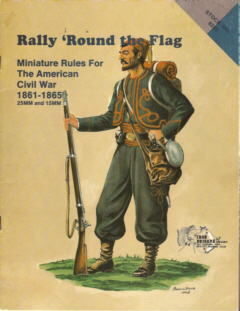|
|
|||||||||||||||||||||||||||||||||||
 |
|
The Rules Directory only works if you help. Write a review. Get the review template here. |
|
TITLE: Rally ‘Round the Flag AUTHOR: S. Craig Taylor, Jr. PUBLISHER: Heritage Model Publications Inc. PUBLICATION DATE: 1976 (Third printing 1982) WEB SITE/SUPPORT FORUM: None known. There is a Yahoo group for a rules set by this name but with a different author. Not sure what relationship (if any) the two have. See here. PRICE (with date): Unknown (Acquired my copy for $2 at a flea market) REVIEWED BY: Mark “Extra Crispy” Severin PERIOD COVERED: The American Civil War THE BOOK: Rally ‘Round the Flag is a slim paperback and includes a card stock sheet of tables. It runs a scant 28 pages of which 8 are the basic rules. Also included is a 5 page section on collecting, painting and basing miniatures, terrain, etc. The advanced rules, charts and some weapons data occupy the remaining pages. SCOPE: Rally ‘Round the Flag (RRtF) is a tactical rules set for the American Civil War (1861-1865). It is designed for players to command a single brigade plus a battery of artillery. ARMY SIZE: In RRtF a player will command a single brigade. This will be made up of approximately 30 bases, including the commander, guns, limbers and wagons. Infantry bases generally have 4 figures per base, though some larger units would have 6 figures per base. BASE UNIT: RRtF uses the regiment, generally made up of four to six stands, as the basic unit. Artillery stands represent two gun sections. GAME SCALES:
BASING SIZES: 15 mm BASING
25 mm BASING
TURN SEQUENCE:
GAME MECHANICS: Charges: Both players first announce all charges and charging units are then moved. Units that are the subject of a charge may react by retreating, counter charging or standing. Once charges are announced charging units are moved into contact with the enemy. Units may also charge objectives or terrain features. Movement: As one would expect, each unit must be in a specific formation (line, column, road column, skirmish or open order). Movement rates are dictated by both formation and terrain. Units may move in any direction without penalty. There is no cost to change formation - but no base may exceed it’s movement allowance (based on it’s starting formation). Fire Combat: All ranged combat whether small arms or artillery is resolved in the same way. First, units have a fire Zone which is generally forward but with a 45 degree fire arc. Artillery must have a limber with appropriate ammunition within 3” in order to fire. To resolve fire the weapon type and range are cross referenced on the Range and Fire Table. This yields a result from 1-15. This number correspond to a Casualty Table. This number can be modified for firing troop quality, cover, formation, sharpshooters, etc. Once the casualty table is determined, the number of firing figures (artillery use their weight) is cross referenced with a die roll (a single D6) to yield a number of casualties inflicted. Casualties are applied to specific stands and when all figures on a stand are hit, the stand is removed. If firing at a non-infantry target there are hit tables to determine whether you hit the gun, crew, horses etc. Limbers taking two hits explode taking nearby friends with them! Melee: Melee is resolved in exactly the same way as fire combat. The basic Casualty Table is determined, the modified for troop quality, cover etc. Each side inflicts damage on the other. Once melee is concluded each side checks morale. If this results in units still being in contact, each unit checks morale again. Continue checking morale until the units are no longer in contact. A player may voluntarily rout a unit if he prefers (though he will take 1D6 losses as prisoners). Morale: When a unit need to check morale, the player rolls two dice. He compares this to the unit’s morale level (Elite units are 10, rack are 9 etc.). The morale value of a unit may be modified by cover, formation, casualties, being outnumbered, generals etc. Units that fail a morale check move to the rear at full speed ignoring terrain costs. Routed units may also be rallied by remaining still for on turn. A unit routed on turn 6 retreats on turn 7. On turn 8 they would rally and be turned to face the enemy. on turn 9 they could then move normally. ADVANCED RULES: RRtF includes a number of advanced rules which players may add or not as desired. These include:
ARMY LISTS/SCENARIOS: The booklet includes no army lists or scenarios. It does include a points system for raising opposing armies of equal strength. REVIEWER’S COMMENTS: RRtF seems like a very straight forward “old school” set of gaming rules. Weapon ranges reflect the thinking of the 1970s with smoothbore muskets firing out to 300 yards and rifle muskets out to 750! The morale conclusion to melee is interesting basically requiring you to check until someone routs. It should be noted that the cover of my version is imprinted “Iron Brigade Miniatures.” I believe they purchased the copyright at some point. PLAYER’S COMMENTS: Not played. To read comments by others or leave one yourself, please send them to me. I’ll post them here for all to see. |
|
[Home] [15mm World] [Reviews Home] [How To] [Beginners Guide] [Gamer's World] [Spanner & The Yank] [Points of View] [The Annex] [Links] [Say Howdy] [Corporate Schill] [Rules Directory] |
 |
